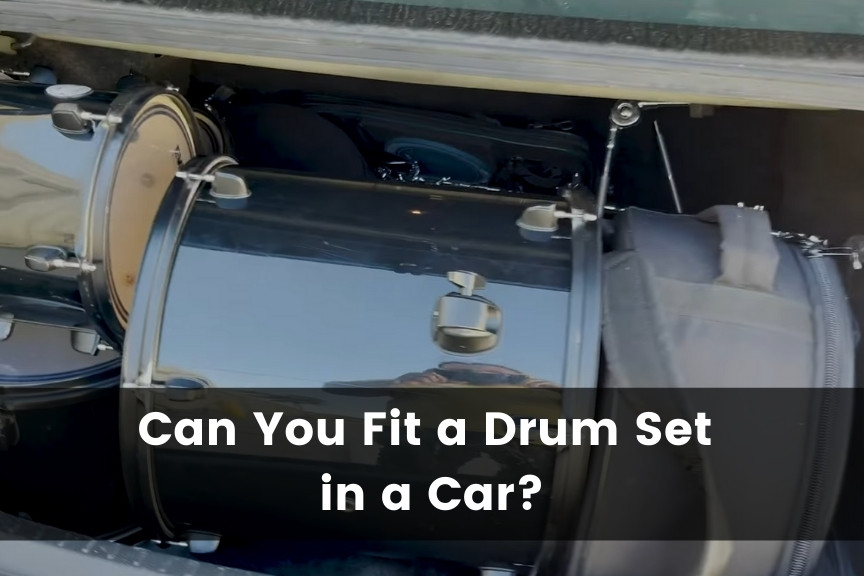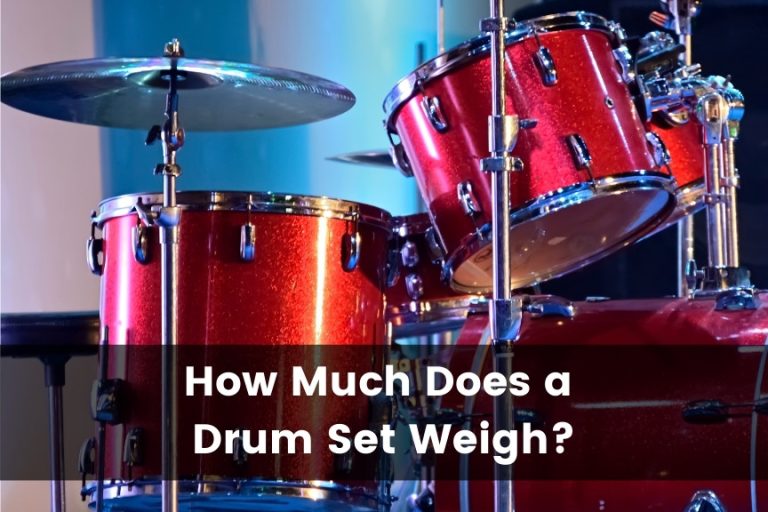Can You Fit a Drum Set in a Car?
Nearly every drummer has watched a flute player walk up to a gig with her small instrument case. She’s not out of breath, and her hands don’t hurt from carrying her flute from the car. And we think, “Why did I pick the drums?”
Fitting a drum set in a car is necessary for most working drummers, and almost any vehicle can hold some semblance of a drum set. If you buy a vehicle with drum transportation in mind, your life will be a little easier.
Of course, depending on your specific car and the drums you want to fit in there, maybe you can’t get it all in your vehicle. But this is a question with so many variables, so let’s work through our options.
To Case or Not To Case
The presence of drum cases completely changes the calculus of fitting your drum set in your car. After all, by definition, the cases are bigger than the drums that fit inside them, so you have some decisions to make and things to consider.
- If I don’t have drum cases, do I need them?
- If I have drum cases, what if I don’t use them?
- What kind of cases do I have or want or need?
- Do I need different cases for my situation?
Depending on the type, drum cases might take up a lot of extra room in your car, or they may add only a couple of inches to the profile of each piece of your drum set.
Soft cases like Gator Cases’ Protechtor Series 5-piece Padded Drum Bag Set on Amazon are form-fitting and protect from cosmetic damage, but if something big falls on one of your drums, the padded nylon cases won’t do much to protect their contents. Since they hug the curves of your drums, you won’t lose much cargo space at all to the presence of the cases.
Hard cases provide more protection but take up more room when you pack your kit into the car. Picking up something like the SKB 8 x 10 Tom Case (also on Amazon) keeps to the shape of each drum it encases, but does increase the profile size of each drum, so you’ll need more room in your car than if you just put the drums in there by themselves.
And what about going without cases? If you’re transporting your drums once a year up to school for a talent show, but the rest of the time, they stay in your home, cases are overkill for you. But if you play gigs regularly, you likely want at least some protection for your kit. Soft-sided cases probably provide all the protection you need if you play around town, but if you’re flying to gigs, you really ought to have hard shells.
But if you’re putting your drums in your car for transportation to gigs, you may be in a playing situation where hard cases would be too much— too bulky for your vehicle and more protection than you need for hauling your drums three miles across town for a two-hour gig playing Big Band Swing.
Your Drum Set
If you play an extensive, Neil Peart-inspired set, you’ll have a more challenging time fitting the whole thing into your car. In this case, we’re talking about a double bass setup and multiple toms, and you need a relatively large car to fit a set like this comfortably. Because we’re talking about cars here, we’re going to leave out SUVs, vans, and pickups, but if your set is a big one, one of those options will be your best bet.
If you play a cocktail set, its extremely compact configuration means that you could conceivably hold it in your hands while you longboard to your gig. Packing one of these into your car poses few problems because, by its nature, a cocktail set’s primary attribute is its compact footprint.
But most of us play kits between these two extremes. The typical five-piece set has a bass drum, a floor tom, two wing toms that mount on top of the bass, and a snare drum. Cymbals include two hi-hat cymbals, a crash, and a ride, and all the hardware that accompanies all this stuff.
This type of set will almost certainly fit in the average sedan. All bets are off if you drive a Smart Car, but your Nissan Stanza or Dodge Dart will do the job.
Average Drum Sizes
Of course, every drum manufacturer has its own sizes, but we can get a general idea of how much space drums take up by looking at some more common drum sizes.
- Bass Drum. Often 22” in diameter with a 16” shell, bass drums are the biggest part of a typical drum set. There are bigger and smaller ones, but we’re going for general sizes here.
- Snare Drum. On the other end is the smallest drum in a typical set. Snares often have 14” diameters and aren’t very deep— a 6” inch (15 cm) snare is pretty big.
- Tom. You probably have two of these sometimes called wing toms because they mount on top of the bass drum and have a vague resemblance to wings if you use your imagination and squint), and there’s a wide range of sizes. Each one will almost certainly be smaller than 12” x 12” (30.5 x 30.5 cm), but again, you need to double the space required.
- Floor Tom. Expect this standalone drum to be at least 14” (35.6 cm) tall, and 16” (40.6 cm) is relatively common, too. They will usually be about 16” (40.6 cm) in diameter.
- Hi-hat Cymbals. Expect each cymbal in this pair to be 14” (35.6 cm) in diameter.
- Crash. We often find 16” (40.6 cm) crash cymbals on sets with just one crash.
- Ride. A 20” (50.1 cm) ride cymbal provides a versatile sound for different musical styles.
Any of these items might measure bigger or smaller depending on your set, what kind of music you play, who built your drums, and how old your equipment is, but these are generalizations for you to use as a starting point.
Packing Your Set
Let me digress a little bit here. In addition to being a professional drummer, I am also a professional double bass player— the upright, acoustic bass often used in jazz or orchestral playing, not the double bass drum set, which is decidedly not used in orchestral music.
In the 20th century, I was a college dropout with no money trying to make a living as a bassist in Nashville. I mention no money because I was driving a 1972 Volkswagen Beetle, which was roughly the size of my bass.
I didn’t have a case for my bass, and I drove a tiny car, but I had to get my instrument to gigs and recording sessions in a city that wasn’t known for walkability in the 1990s. I had to learn by trial and error, which is why I took this detour in this article— you will have to do the same thing. You know your car, you know your set, and like anything else, the more you pack your drum kit into your vehicle, the better you’ll get at it.
I eventually worked out a system that involved dressing my bass in oversized sweatshirts, removing my car’s front seat, and playing real-life, oversized Tetris whenever I had a gig. I couldn’t load up quickly, but I could do it because I had to do it.
You can do the same thing. Again, if you have a giant kit and drive a Triumph, maybe not, but average sets in average cars? You can make that work.
The Car Matters Less Than Your Packing Skills
We all know someone who packs for a trip by using graduate-level origami skills to get an insane amount of clothing into a ridiculously small bag. And then there’s the friend who has no idea how to pack efficiently and needs two bags for an overnight trip.
No matter what you drive, you’ll need to have more skills of the former than the latter. And for heaven’s sake, do a dry run on packing a day or two before your gig. The best time to learn you can’t fit it all in your car is not 30 minutes before the gig starts.
A Blueprint
For the items that can fit in your backseat, put them there. Save the trunk for things that won’t fit in the car. For instance, if you have a dedicated case for all your hardware, while it may work in the back seat, you might not be able to fit anything else in there with it.
Whether you have a hard case like the Crossrock Drum Hardware Case with Wheels, a soft case like the Tama PowerPad Hardware Bag, or something in between like the Stagg PSB-48/T Hardware Bag, they all take up a lot of room.
Filled with all those cymbal stands, pegs, and mounting hardware, a hardware case gets very heavy very quickly, too. It may be difficult to move something so unwieldy into, out of, and around in your back seat. And if your hardware case consists of just wrapping it all up in the rug your drum set sits on, that brings its own maneuverability issues, and moving it into the trunk may be much easier.
In the Back Seat
Your floor tom can sit on the seat. It will probably be too tall to stack anything on that won’t topple when you take a curve, so if it’s behind the passenger seat, then that side is full.
Next to it, you should be able to stack your two other toms. Your snare drum might nestle in the floorboard behind one of the front seats, and you can slide your cymbals behind the other front seat.
A word about cymbals here: cymbals are relatively fragile even though we beat them pretty mercilessly when we play. They’re also expensive, so it would be wise to invest in some type of cymbal case. Even soft-sided cases at least keep them from sliding around and falling out and to the ground.
The ProTec HR230 Cymbal Bag does the job. A hard case like the SKB Cymbal Vault provides excellent protection and should still fit behind your car seat. If you don’t have a cymbal case, at the very least, stack your cymbals, then thread the hi-hat clutch through them all and screw it together. Rather than having four or more cymbals to keep track of, you’ll have one piece of hardware to deal with in terms of packing, loading, and unloading.
In the Trunk
Unless you have a massive bass drum or a tiny trunk, you should be able to fit the remainder of your set in the trunk. Slide the bass drum in first since your trunk might be too narrow to fit the hardware case up against the back seat.
Then slide the hardware case in, and as a bonus, you’ll be able to offload that first, get it into place, and make setup a little more efficient.
Personal Touches
Obviously, if your set uses two floor toms, you’ll need to tweak this blueprint. Or perhaps your bass drum won’t go in the trunk. Maybe you carry a second snare drum. No matter. Use the blueprint and make the adjustments you need.
The most important thing to remember is that you have to pack your drums safely— not only so they don’t get damaged, but also so you don’t have loose drums careening around the interior of your car and making you a danger to other drivers.
Cars To Consider
If you’re in the market for a car, you certainly want to think about your drum transport needs. I’m not sure if a test drive can involve loading your drums up to see how they fit, but you can at least examine cargo space and consider how much space your set takes up when it’s packed for transport.
Car manufacturers provide a total passenger volume specification for their vehicles, but not all of that space can accommodate drums. The driver needs some of that space, and not many of us will stack drums all the way up to the ceiling, so not all that volume is usable.
You can look at the amount of trunk space and have an idea of what of yours will fit, and then you may need to physically see the interior of any car you plan to buy. Here are some measurements of some popular sedans in descending order of trunk space.
| Vehicle | Trunk space | Total Passenger Volume |
| Chevrolet Impala | 18.8 cubic feet(0.53 cubic meters) | 105 cubic feet(2.97 cubic meters) |
| Honda Accord | 16.7 cubic feet(0.47 cubic meters) | 105.6 cubic feet(2.99 cubic meters) |
| Chevrolet Malibu | 15.7 cubic feet(0.445 cubic meters) | 102.9 cubic feet(2.91 cubic meters) |
| Nissan Altima | 15.4 cubic feet(0.436 cubic meters) | 98.8 cubic feet(2.79 cubic meters) |
| Kia Forte | 15.3 cubic feet(0.433 cubic meters) | 96 cubic feet(2.72 cubic meters) |
| Honda Civic | 15.1 cubic feet(0.428 cubic meters) | 97.8 cubic feet(2.77 cubic meters) |
| Toyota Camry | 15.1 cubic feet(0.428 cubic meters) | 100.4 cubic feet(2.84 cubic meters) |
| Tesla Model 3 | 15 cubic feet(0.42 cubic meters) | 112 cubic feet(3.17 cubic meters) |
| Ford Focus | 13.2 cubic feet(0.373 cubic meters) | 90.7 cubic feet(2.57 cubic meters) |
| Toyota Corolla | 13 cubic feet(0.368 cubic meters) | 88.6 cubic feet(2.51 cubic meters) |
Ideally, you’ll find a spacious, roomy vehicle with room enough for quick, easy loading and unloading. Realistically, though, many of us will make do with what we have, pack the best we can, and get to the gig.
Knowing the measurements of your own car may help you plan your packing better, though, so if your car isn’t listed above, consult your dealership for specs if you’re interested.
Other Vehicle Considerations
In general, the larger the car, the lower its gas mileage, which may be a real concern for a working musician now that the days of being outraged that a gallon of gas costs rose to $.75 are long gone.
Hybrids and electric vehicles can help offset transportation costs, but you may have to give up some storage space, as many of these cars are on the smaller side. Not all of them— the Toyota Camry Hybrid is exactly the same size as a Camry— but for some, a complete drum set might be a tight fit.
Packing It In
You probably already have an idea of how to fit your set into your car when it’s time to move it to a gig or rehearsal.
If you’ve never tried it before, allow yourself time to figure out the best way to fit your drum set into your car because the first few times you try it, you may find yourself running into some dead ends and having to unpack everything and start over.
In most cases, you can fit your drum set into your car, but what works for you will be specific to you and all the variables surrounding your kit and vehicle.







